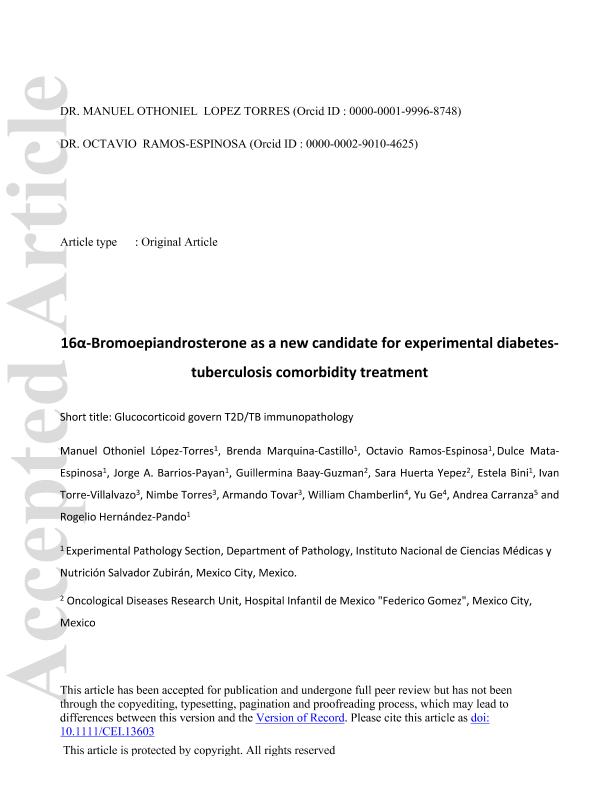Artículo
16α‐Bromoepiandrosterone as a new candidate for experimental diabetes‐tuberculosis comorbidity treatment
López Torres, Manuel Othoniel; Marquina Castillo, Brenda; Ramos Espinosa, Octavio; Mata Espinosa, Dulce; Barrios Payan, Jorge A.; Baay Guzman, Guillermina; Huerta Yepez, Sara; Bini, Estela Isabel; Torre Villalvazo, Ivan; Torres, Nimbe; Tovar, Armando; Chamberlin, William; Ge, Yu; Carranza, Maria Andrea ; Hernández Pando, Rogelio
; Hernández Pando, Rogelio
 ; Hernández Pando, Rogelio
; Hernández Pando, Rogelio
Fecha de publicación:
04/2021
Editorial:
Wiley Blackwell Publishing, Inc
Revista:
Clinical and Experimental Immunology
ISSN:
0009-9104
Idioma:
Inglés
Tipo de recurso:
Artículo publicado
Clasificación temática:
Resumen
Tuberculosis (TB) is the leading cause of death from a single bacterial infectious agent and is one of the most relevant issues of public health. Another pandemic disease is type II diabetes mellitus (T2D) that is estimated to affect half a billion people in the world. T2D is directly associated with obesity and a sedentary lifestyle and is frequently associated with immunosuppression. Immune dysfunction induced by hyperglycemia increases infection frequency and severity. Thus, in developing countries the T2D/TB co-morbidity is frequent and represents one of the most significant challenges for the health-care systems. Several immunoendocrine abnormalities are occurring during the chronic phase of both diseases, such as high extra-adrenal production of active glucocorticoids (GCs) by the activity of 11-β-hydroxysteroid dehydrogenase type 1 (11-βHSD1). 11-βHSD1 catalyzes the conversion of inactive cortisone to active cortisol or corticosterone in lungs and liver, while 11-β-hydroxysteroid dehydrogenase type 2 (11-βHSD2) has the opposite effect. Active GCs have been related to insulin resistance and suppression of Th1 responses, which are deleterious factors in both T2D and TB. The anabolic adrenal hormone dehydroepiandrosterone (DHEA) exerts antagonistic effects on GC signaling in immune cells and metabolic tissues; however, its anabolic effects prohibit its use to treat immunoendocrine diseases. 16α-bromoepiandrosterone (BEA) is a water miscible synthetic sterol related to DHEA that lacks an anabolic effect while amplifying the immune and metabolic properties with important potential therapeutic uses. In this work, we compared the expression of 11-βHSD1 and the therapeutic efficacy of BEA in diabetic mice infected with tuberculosis (TB) (T2D/TB) with respect to non-diabetic TB-infected mice (TB). T2D was induced by feeding mice with a high-fat diet and administering a single low-dose of streptozotocin. After 4 weeks of T2D establishment, mice were infected intratracheally with a high-dose of Mycobacterium tuberculosis strain H37Rv. Then, mice were treated with BEA three times a week by subcutaneous and intratracheal routes. Infection with TB increased the expression of 11-βHSD1 and corticosterone in the lungs and liver of both T2D/TB and TB mice; however, T2D/TB mice developed a more severe lung disease than TB mice. In comparison with untreated animals, BEA decreased GC and 11-βHSD1 expression while increasing 11-βHSD2 expression. These molecular effects of BEA were associated with a reduction in hyperglycemia and liver steatosis, lower lung bacillary loads and pneumonia. These results uphold BEA as a promising effective therapy for the T2D/TB co-morbidity.
Archivos asociados
Licencia
Identificadores
Colecciones
Articulos (IATIMET)
Articulos de INSTITUTO ALBERTO C. TAQUINI DE INVESTIGACIONES EN MEDICINA TRASLACIONAL
Articulos de INSTITUTO ALBERTO C. TAQUINI DE INVESTIGACIONES EN MEDICINA TRASLACIONAL
Citación
López Torres, Manuel Othoniel; Marquina Castillo, Brenda; Ramos Espinosa, Octavio; Mata Espinosa, Dulce; Barrios Payan, Jorge A.; et al.; 16α‐Bromoepiandrosterone as a new candidate for experimental diabetes‐tuberculosis comorbidity treatment; Wiley Blackwell Publishing, Inc; Clinical and Experimental Immunology; 205; 2; 4-2021; 232-245
Compartir
Altmétricas



